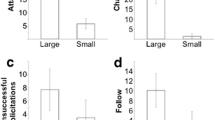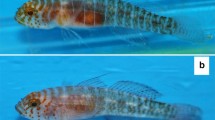Summary
Operational sex ratio (OSR) was proposed by Emlen and Oring (1977) as an empirical measure of the intensity of sexual selection. Few studies, however, have examined the link between OSR and levels of intrasexual competition, which may influence selection. We studied the seasonal relationship between OSR and female-female competition for mates in Wilson's phalarope (Phalaropus tricolor), a sex-role reversed, non-territorial shorebird. Positive correlations between four measures of OSR (Scan Ratio, Day Ratio, Focal Ratio, and Chase Ratio) indicated seasonal changes in the availability of mates for females. Changes in mate availability resulted from the interaction between paternal care and female emancipation, asynchronous spring arrival schedules of the sexes (Reynolds et al. 1986), and the effect of clutch failure on renesting opportunities. Measures of intrasexual competition (courtship chases, percent males defended, rate and intensity of mate defense, and female-male proximity) varied significantly within and among years. Univariate and multivariate correlations indicated general agreement between measures of OSR and estimates of intrasexual competition. Our results suggest that OSR may provide a useful estimate of the opportunity for sexual selection, especially in species with matedefense mating systems.
Similar content being viewed by others
References
Altmann J (1974) Observational study of behaviour: sampling methods. Behaviour 49:227–265
Arnold SJ, Wade MJ (1984) On the measurement of natural and sexual selection: theory. Evolution 38:709–719
Bateman AJ (1948) Intrasexual selection in Drosophila. Heredity 2:349–368
Bateson P (1983) Mate choice. Cambridge Univ Press, Cambridge
Colwell MA (1986a) The first documented case of polyandry for Wilson's phalarope (Phalaropus tricolor). Auk 103:611–612
Colwell MA (1986b) Intraspecific brood parasitism in three species of prairie-breeding shorebirds. Wilson Bull 98:473–475
Curtis PD, Braun CE, Ryder RA (1983) Wing markers: visibility, wear, and effects on survival of band-tailed pigeons. J Field Ornithol 54:381–386
Emlen ST, Oring LW (1977) Ecology, sexual selection, and the evolution of mating systems. Science 197:215–223
Falconer DS (1981) Introduction to quantitative genetics. Longman, London
Hildén O, Vuolanto S (1972) Breeding biology of the rednecked phalarope Phalaropus lobatus in Finland. Ornis Fennica 49:57–85
Höhn O (1969) The phalarope. Sci Am 220:105–111
Howe MA (1975) Social interactions in flocks of courting Wilson's phalaropes (Phalaropus tricolor). Condor 77:24–33
Lande R, Arnold SJ (1983) The measurement of selection on correlated characters. Evolution 37:1210–1226
Oring LW (1982) Avian mating systems. In: Farner DS, King JR, Parkes KC (eds) Avian biology, vol 6. Academic Press, New York, pp 1–92
Oring LW (1985) Avian polyandry. In: Johnston RF (ed) Current Ornithology, vol 3. Plenum Press, New York, pp 309–351
Raner L (1972) Förekommer polyandri hos smalnäbbad simsnäppa (Phalaropus lobatus) och svartsnäppa (Tringa erythropus)? Fauna Flora 3:135–138
Reynolds JD (1987) Mating system and nesting biology of the sex-role reversed red-necked phalarope: What constrains polyandry? Ibis 129:225–242
Reynolds JD, Colwell MA, Cooke F (1986) Sexual selection and spring arrival times of red-necked and Wilson's phalaropes. Behav Ecol Sociobiol 18:303–310
Schamel D, Tracy D (1977) Polyandry, replacement clutches, and site tenacity in the red phalarope (Phalaropus fulicarius) at Barrow Alaska. Bird-banding 48:314–324
Schwagmeyer PL, Brown CH (1983) Factors affecting malemale competition in thirteen-lined ground squirrels. Behav Ecol Sociobiol 13:1–6
Schwagmeyer PL, Woontner SJ (1985) Mating competition in an asocial ground squirrel, Spermophilus tridecemlineatus. Behav Ecol Sociobiol, 17:291–296
Sutherland WJ (1985) Chance can produce a sex difference in variance in mating success and explain Bateman's data. Anim Behav 33:1349–1352
Trivers RL (1972) Parental investment and sexual selection. In: Campbell B (ed) Sexual selection and the descent of man. Aldine, Chicago, pp 139–179
Wade MJ, Arnold SJ (1980) The intensity of sexual selection in relation to male sexual behaviour, female choice, and sperm precedence. Anim Behav 28:446–461
Wilson EO (1975) Sociobiology: the new synthesis. Belknap Press, Harvard
Author information
Authors and Affiliations
Rights and permissions
About this article
Cite this article
Colwell, M.A., Oring, L.W. Sex ratios and intrasexual competition for mates in a sex-role reversed shorebird, Wilson's phalarope (Phalaropus tricolor). Behav Ecol Sociobiol 22, 165–173 (1988). https://doi.org/10.1007/BF00300566
Received:
Accepted:
Issue Date:
DOI: https://doi.org/10.1007/BF00300566




